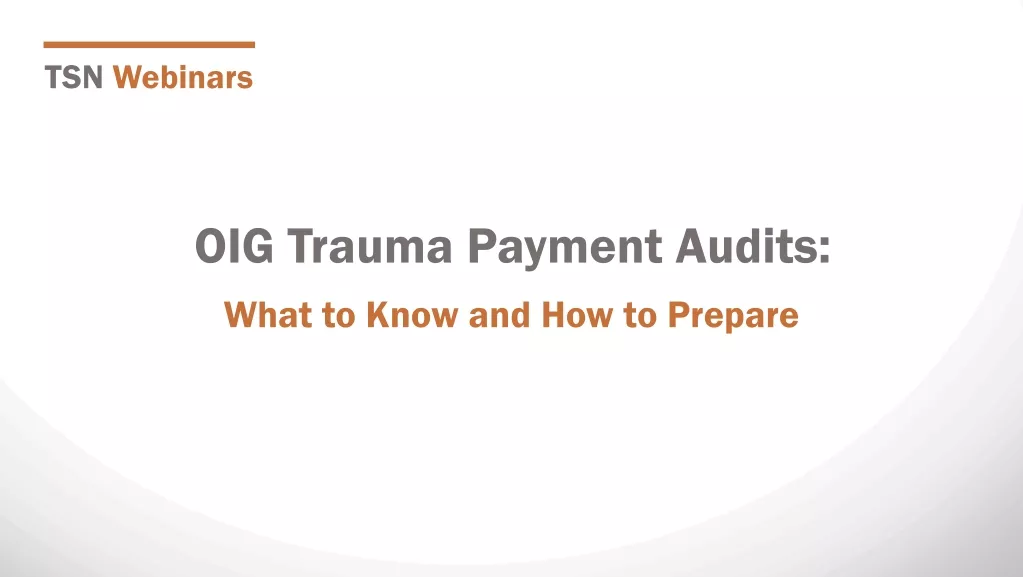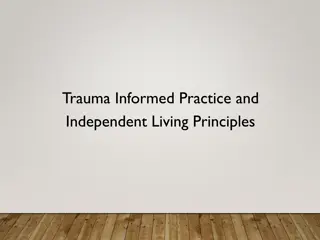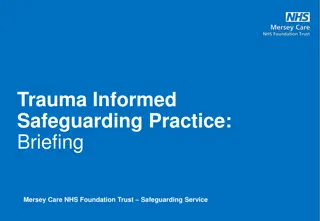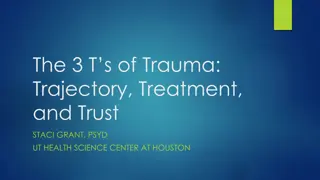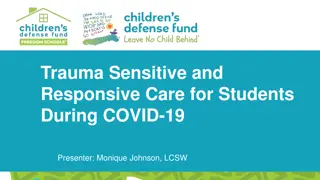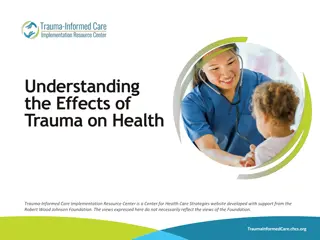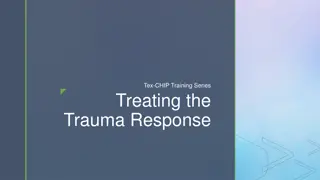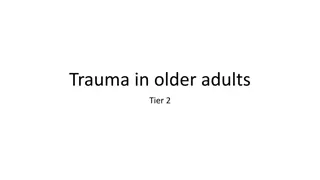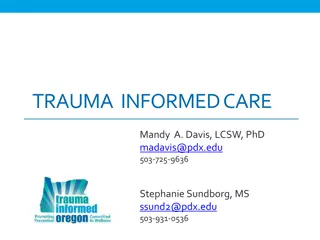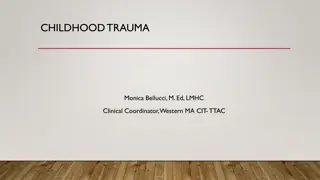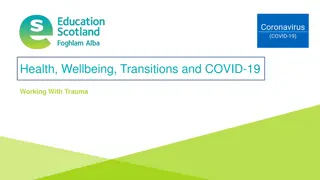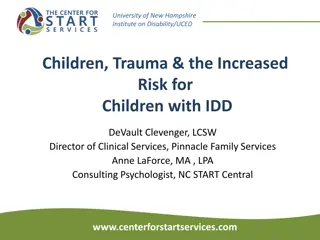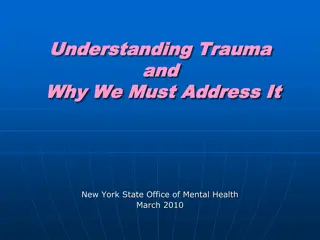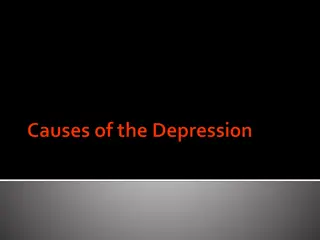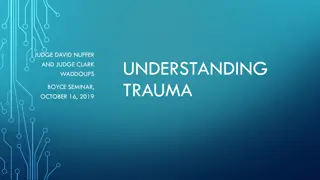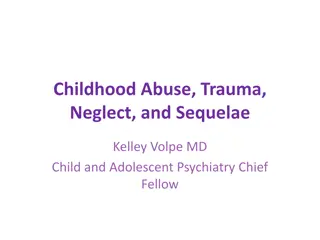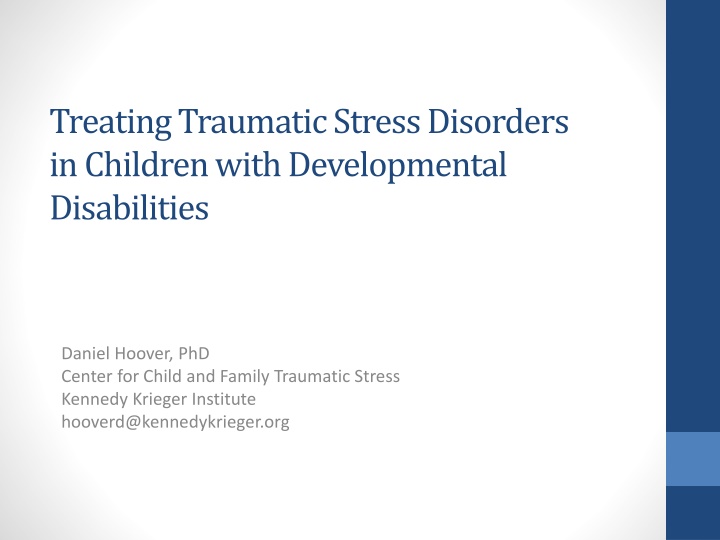
Supporting Children with Developmental Disabilities and Traumatic Stress
Explore the intersection of developmental disabilities and traumatic stress in children, highlighting the impact of trauma exposure, including child maltreatment and violence. Learn about the frameworks and research findings shaping interventions and support strategies for children with IDD who have experienced trauma.
Download Presentation

Please find below an Image/Link to download the presentation.
The content on the website is provided AS IS for your information and personal use only. It may not be sold, licensed, or shared on other websites without obtaining consent from the author. If you encounter any issues during the download, it is possible that the publisher has removed the file from their server.
You are allowed to download the files provided on this website for personal or commercial use, subject to the condition that they are used lawfully. All files are the property of their respective owners.
The content on the website is provided AS IS for your information and personal use only. It may not be sold, licensed, or shared on other websites without obtaining consent from the author.
E N D
Presentation Transcript
Treating Traumatic Stress Disorders in Children with Developmental Disabilities Daniel Hoover, PhD Center for Child and Family Traumatic Stress Kennedy Krieger Institute hooverd@kennedykrieger.org
The Road to Recovery: Supporting Children with IDD Who Have Experienced Trauma
Interacting Influences IDD Mental Health Trauma What are the frameworks you use in your work? 3 3
Traumatic Life Events Child maltreatment (physical, sexual, psychological abuse) Car accident or crash Animal attack Man-made disasters Natural disasters Witnessed another person being beaten, raped, threatened, shot at Traumatic grief and loss
National Survey of Childrens Exposure to Violence (2009) More than 60% of children under 17 exposed to violence in the past year 46.3% had been assaulted in the past year (10.2% injured) 24% victims of robbery, vandalism, or theft
National Survey of Childrens Exposure to Violence (2009) 10.2% experienced child maltreatment (physical abuse, neglect, emotional abuse, family abduction) 25.3% witnessed a violent act 9.8% saw one family member assault another
National Survey of Childrens Exposure to Violence (2009) 10.9% had more than one victimization in past year 6.1% sexually victimized PTSD relatively rare but much more common for multiple episodes
Trauma exposure in children with developmental disabilities Some studies suggest children with DD s are more likely to be victimized: Two-three times as likely as typically developing youth, depending on disability type and setting (Sullivan, 2009; Turner et al., 2011) Sexual abuse most common among disabled children (Kvam, 2000) More often exposed to restraint and seclusion (Sullivan, 2006) Children with ASD s bullied even in special education settings (von Roekel, Scholte, & Didden, 2011)
Trauma exposure in children with Developmental Disabilities Other studies suggest more caution: Depends on type of study, methodological rigor, and definition of disability (Leeb, Bitsko, Merrick, & Armour, 2012) Mehtar & Mukaddes, 2011- no greater incidence of trauma exposure in youth with ASD s, but high rate of PTSD and exacerbation of social and communication difficulties, self-injury, and decline in self-care skills
Core Concept 1: Complexity There s a lot going on in the child s mind and body. For a family & child with IDD Moment-to-moment reactions can be even more complex due to physical, cognitive or communicative limitations that impact the range of protective actions that were possible during the traumatic experience. 10 10
Physiological & Developmental Changes May see regression in: Sleep Appetite Startle response and sensory processing problems Toileting, self-care Speech and language Stereotypies/repetitive movements
Changes in Emotion and Behavior Attention Avoidance Meltdowns Anxiety Ability to sit still Ability to be soothed Reactions to people Multiple mental health diagnoses and slow response to treatment
Trauma Reminders For the longest time we couldn t understand why Billy was always acting out and seemed unhappy on our holiday trips to the mountains. We didn t realize that the smell of wood burning in a fire was a reminder of the the ski trip to Colorado, during which Billy was assaulted. http://sincerelyjenni.com/wp-content/uploads/2012/01/Fostering-A-Disabled-Child-297x300.jpg 13 13
Identify Trauma-Informed Service & Treatment Needs of Children and Families Not every child needs trauma-focused treatment. Screening Trauma screening and assessment help identify the children who most need trauma- focused therapy. Assessment Consider the type of trauma experienced when making service referrals & service plans. Treatment Assess the functioning of the caregiving system, including the impact of parent trauma. 14 14
Trauma Screening for Parents/Caregivers Many caregivers have histories of trauma (in childhood & adulthood). Trauma can impact parenting & protective capacities. Awareness of parental/caregiver trauma history helps providers better understand parents/caregivers and link them to appropriate services. Examples of screening tools for parents: Parent Emotional Reaction Questionnaire Life Events Checklist Trauma Recovery Scale Child Disorders Checklist Screening Form (CSDC-SF) 15 15
Trauma Assessment A more in-depth exploration of the nature & severity of the traumatic events, the impact of those events, current trauma-related symptoms & functional impairment Includes a clinical interview, use of objective measures, behavioral observations of the child, and collateral contacts with family, caseworkers, etc Usually conducted by a mental health provider to drive treatment planning May occur over at least 2-3 sessions Should be used to determine the treatment plan 16 1 6 16
Special Issues: Assessing trauma in Children with IDD Who should be involved? Who should be involved? Multiple reporters- caregivers, teachers, providers Very important to get child report but this can be difficult What Measures? What Measures? High false negative and false positive rates in ASD for many scales Others need norms for IDD Adaptive behavior measures seem helpful
Interactive Trauma Scale for Interactive Trauma Scale for ASD ASD/ /IDD IDD Tablet-based app in development Daniel Hoover, PhD, ABPP/ HCB +- Houston TX
Strengthen Family Protective Factors Help Families Navigate Systems of Care, including systems challenges Ask & Answer Parents/Caregivers Questions Help Families Access IDD- & Trauma-Informed Support & Services Promote Family-Informed Child-Centered Planning Provide Timely Information Promote a Healing & Protective Environment Promote Secure Attachment Address Trauma Experiences of Parents/Caregivers Partner with Parents and Caregivers to Create a Recovery Team 19 19
Positive Identity Development Developed by Karyn Harvey, PhD to assist individuals with IDD in revealing their true potential as human beings & experiencing the happiness in life that they so deserve Positive identity development for children with IDD focuses on discovering, defining & celebrating the self vs taking on the sole identity of disabled Basic premise is that an approach modeled on psychological well-being vs ineffective behaviors leads to human health & authentic happiness 20 20
Materials accompany Positive Identity Development: An Alternative Treatment Approach for Individuals with Mild and Moderate Intellectual Disabilities (Harvey, 2009) Available at pid.thenadd.org 21 21

